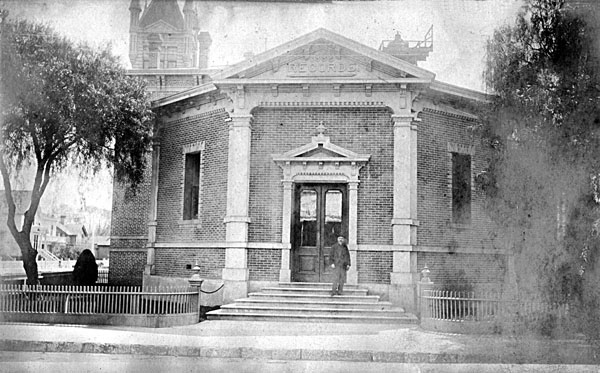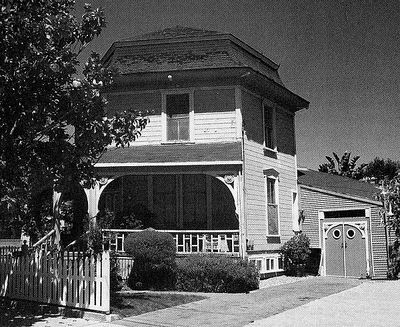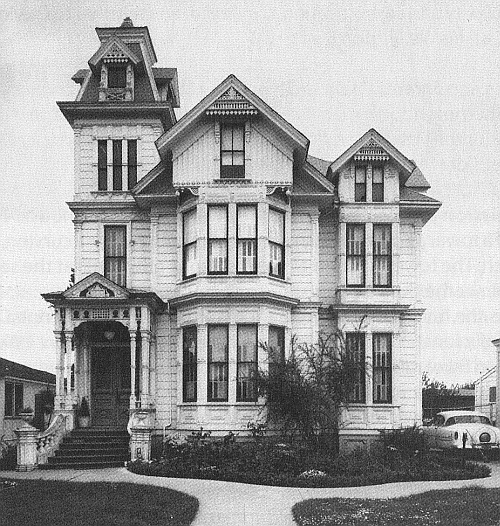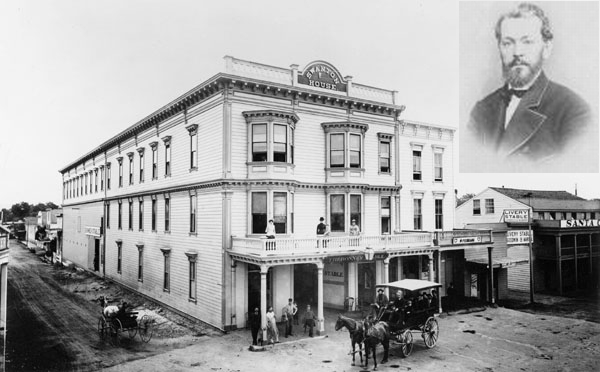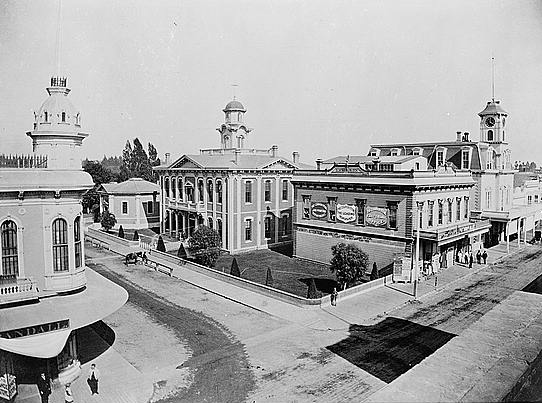History Pages: 47 - Santa Cruz gets an Octagon: downtown in the early 1880s
For a table of contents, see History pages.
By 1880, there were few vacant lots in the core of downtown Santa Cruz. One prominent spot remained, but that changed in 1882 when Santa Cruz County built a new Hall of Records on the lot next to the courthouse, at the corner of Cooper and Front streets (photo at right). The Italianate style of the front façade coordinated nicely with the sixteen-year-old courthouse.
The rest of the little building, however, was a surprise. Oakland architect J. W. Newcum chose an octagonal shape, the only such public building ever built in Santa Cruz, although several small octagonal residential cottages were built in the Seabright neighborhood. BTW: the building and tower visible to the left and behind the Octagon in the photo is the 1890 County Jail. To its right is the fire alarm bell tower, erected in 1878.
Another surviving building with an unusual shape was built not far away just a couple of years later. Perhaps inspired by the octagonal Hall of Records, a hexagon-shaped house was built in 1884 down on Sycamore St. Note the curved steep-pitched roof, borrowed from the Second-Empire style popular a few years earlier (the porch and garage were added later).
About the same time, a much larger and more traditionally-shaped house went up on Mission Street, across from the plaza. Calvin Davis and his brother Wellington were very busy designer-builders in Santa Cruz during the 1870s. The brothers collaborated on a big house on the hill for Calvin, second only to the Hihn mansion (which the brothers also designed and built). Still in excellent condition, the Davis house (photo at right) is one of the finest historical homes in town.
Two other profitable businesses in Santa Cruz in those years were livery stables and hotels. A. P. Swanton had both - first a stable, then a hotel - at the corner of Front and Water streets. By 1884, he had done well enough to build a new hotel on the site (with expanded stables on the ground floor). Hotel guests today would probably balk at a room above a horse barn, but horses were a fact of life in the 1880s, so noses were perhaps not so sensitive.
The inset photo shows A. P. Swanton in 1886. If the name Swanton sounds familiar, it’s because of A. P. Swanton’s son Fred, who grew up into a most ambitious local entrepreneur/promoter a few years later. Among Fred Swanton’s lasting contributions to the Santa Cruz scene were the beginnings of today’s Santa Cruz Beach Boardwalk.
It’s worth mentioning a couple of other locals whose building endeavors haven’t been mentioned previously in this blog, and which can be seen in this photo showing Cooper Street from Pacific Avenue. The two-story 1870s building at the far left corner of Pacific and Cooper housed owner Mike Leonard’s saloon. Leonard repeated the corner dome on his second building, built in 1894 and still standing at the corner of Cooper and Front.
To the right of the Octagon is the 1866 County Courthouse, and to the right of that is a boxy structure that carried the prosaic name of “Ely’s Block”. Built in 1876, it was an eponymous enterprise of William Ely, a former 49er who moved to Santa Cruz in 1870 to become a developer and streetcar investor. Ely later built another “block” on the other side of the Oddfellows Building (that’s the building to the far right sporting the first iteration of our town clock). Stubbornly defying imagination, the two buildings became known as “Ely’s Block No. 1” and “Ely’s Block No. 2”.
Looking at that photo, I bet County officials wished they had bought more of that Pacific-Cooper corner property, to give the courthouse more space. Following the 1894 fire that destroyed both buildings, that’s exactly what they did to build the second courthouse – later known as Cooper House.
One more note: look at the street paving in the Cooper Street view and the Swanton House photo. These were the years when Santa Cruz was getting its first street paving, using locally-mined bituminous rock (see History Pages: 43 - Petroleum in Santa Cruz, Then and Now). Edges of the new paving can be clearly seen at the Pacific-Cooper junction, and at the Front-Water Street meeting in front of Swanton House (Water Street is the muddy one to the left of the hotel).
Notes
- See before-after photos of the Front-Cooper corner at History Pages: 30 – How the Town Became a City
- Chase, John L. The Sidewalk Companion to Santa Cruz Architecture (2005 book). The Sycamore Street hexagon house is item (10), Chapter Two.
- Elliott, W. W. Santa Cruz County, Calif. Illustrations, with Historical Sketch (1879 book)
- Santa Cruz Public Library historical photo collection
Next: History Pages: 47 - Santa Cruz in 1882: Water Street Gets a New Bridge
